When Tom "Cork" Kenny got a tip-off from a police contact in Clifden early on a Sunday morning to say two men had just landed a plane in a bog near the town, and were claiming to have flown across the Atlantic, he didn't waste a second.
The dashing young editor of the Connacht Tribune raced to his Model T Ford, and pointed it west. It was June 15th, 1919 – exactly 100 years ago next Saturday – and traffic in Galway was light. He covered the 49 miles (or about 80km) from the city centre at a fair clip, pushing his car close to its top speed of 45mph (or about 70km/h) all the way.
Less than two hours later he was rewarded with the scoop of a lifetime, beating a press pack from the biggest news organisations in the world to a story that would change everything.
Alcock and Brown guided their plane onto what they thought was a lush green field near Clifden, and were less than pleased when it sank nose first into the bog
Seven-year-old Harry O’Sullivan should have been on his way to Mass with his family that same morning, but a case of measles and his mother’s fear that the illness might make him more vulnerable to the Spanish flu – which was, at the time, killing millions of people across the world – saw him confined to his house in Clifden, while his family went out to pray.
He was lying in bed feeling sick and sorry for himself when he heard a deafening roar directly over his head. Terrified but excited, he raced onto the street and, by chance, claimed a very small place in history as one of the first people to watch a plane fly in off the Atlantic straight from America.
An Australian soldier on his honeymoon looking out a hotel window in the town and a farmer’s boy tending cattle nearby were also staring slack-jawed as the plane came spluttering through the mist.
John Alcock and Arthur Whitten Brown were at its controls. They guided the open cockpit plane onto what they thought was a lush green field near the Marconi Wireless transmission station, about 7km from Clifden, and were less than pleased when it immediately sank nose first into the bog.
They took the mishap in their stride, and once they had clambered out of the Vickers Vimy Atlantic under the wary gaze of Marconi station staff, they could scarcely have been more laid back. “That is the way to fly the Atlantic,” Brown the navigator said matter-of-factly. Dusting himself down, Alcock told the onlookers that “if we had a shave and a bath, we should be alright.”
Just under 16 hours earlier, the young aviators had flown down a bumpy make-shift runway built on the remote outcrop of St John’s in Newfoundland, and into the unknown.
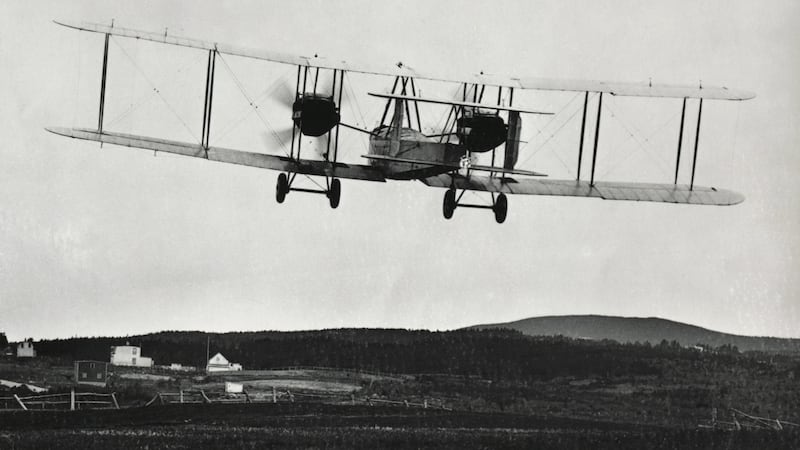
By any measure, their arrival in Ireland was miraculous. After take-off, they climbed to 11,OOO feet (3,353m) in an attempt to get above the clouds so they could navigate by the stars, but no matter how high they climbed, they couldn’t shake off the shroud of grey that enveloped them.
Within minutes of reaching the bitterly cold altitude, their plane’s heating system broke. Then its basic communications tools failed, so they couldn’t even talk to each other over the drone of the engines.
They flew through hail and snow, and temperatures fell so low that parts of their engine froze. Half way across the Atlantic, Brown had to stand in the cockpit and scrape ice off key components to keep the motor running.
On at least two other occasions, the plane came within feet of crashing into the ocean. At one point, it was just 65 feet above the waves before Alcock regained control, but several hours later, they found themselves flying headlong into the water again. By the time Alcock righted the plane, he could taste salt on his lips from the waves below.
For another spell, completely disorientated by cloud, they turned upside down but on they flew, eating sandwiches and chocolate and drinking lukewarm coffee as they travelled at just over 100mph (or 160km/h).
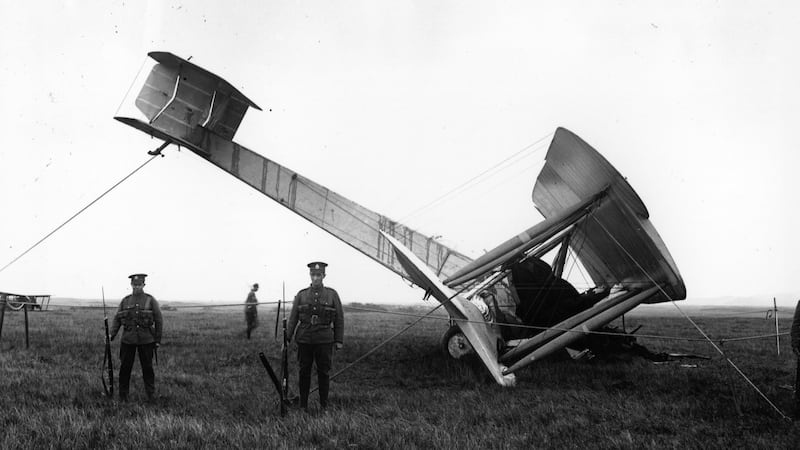
Exactly 15 hours and 57 minutes after take-off, Alcock and Brown landed in Derrigimlagh Bog outside Clifden. They were brought to a house on the sprawling Marconi complex, built in the west of Ireland years earlier because of Connemara’s clear line of sight to the United States.
Tom “Cork”’ Kenny met them there. Writing in The Irish Times days later, the journalist said of Alcock that he “looked as spruce, attired in a navy lounge suit, and cheerfully smoking a cigarette as any city man enjoying an hour’s content.”
The pilot was happy to talk. “Most of the time we were compelled to fly between clouds and very thick banks of fog. Indeed, the conditions were anything but pleasant,” he told Kenny. “Sleet fell and our radiator shutters got frozen up, while all our petrol gauges were covered over with ice . . . The weather was very rough and very bumpy and the wind was blowing hard right down to the water . . . We never saw the sky even for more than half an hour after the first hour out.”
When asked about his overall impressions of the journey, Alcock said there was “no sense of remoteness, curious to say – we were too keen on our work we wanted to get the job done and were jolly pleased, I tell you, to see the coast.”
His calmness after the flight was the measure of the man, his nephew, Tony Alcock, says over the phone from his home near Ipswich.
Born in Manchester in 1892, Sir John – as Tony calls him – was interested in flying from a young age, building kites and hot air balloons. But getting into the air himself seemed like an impossible dream. “Most of people flying planes before the first World War were wealthy entrepreneurs, but my uncle was basically a working class boy who had left school at 16,” the younger Alcock explains.
From school, he joined the Empress engineering firm in Manchester and within two years was promoted to head mechanic. The Empress owner, Charles Fletcher, was a keen flier and he and Alcock became trusted allies.
The young engineer was charged with delivering a motor to Brookland’s near London, where British aviation was centred. While there he met early flight pioneer Maurice Ducrocq, who offered him a job. Ducrocq also knew Brown but the pair did not meet – not yet.
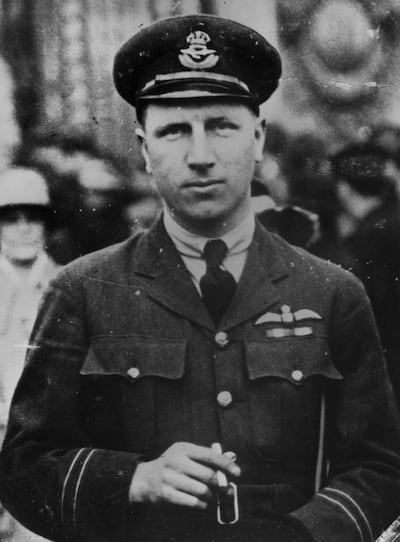
“When he arrived at Brookland’s there was a real buzz, and the sky above was full of aircraft,” Tony Alcock says. “Many of the crews flying there would eventually end up competing in the race across the Atlantic, so they knew each other and there was a healthy rivalry and a great respect. They all shared the aim of going further and going faster.”
“Sir John” was just 20 when he got his pilot’s license in 1912.
Then war came, and he joined the embryonic Royal Air Force (RAF). He flew long range bombing raids over the Turkish front, and was shot down over Suvla Bay and sent to a POW camp, where he spent months kicking his heels and dreaming of flying again.
Scottish born Arthur Whitten Brown grew up in Manchester, and like Alcock, he enlisted in 1914. He fought in the land war – in Ypres and the Somme – before joining the RAF. He too was shot down – over Germany – and spent time in a POW camp before being repatriated to England with serious leg injuries.
Immediately after the war, the Vickers aircraft manufacturers set about converting one of their bomber planes into something that could fly an ocean. Alcock had been working as a test pilot with the firm, and was paired with Brown in the spring of 1919. Together they sailed across the Atlantic to Canada, to join an amazing race.
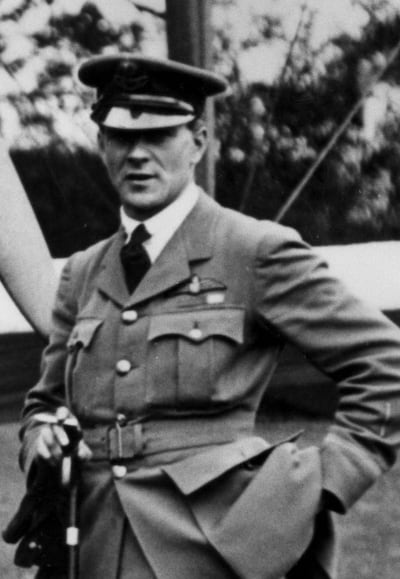
In 1913, the Chapelizod-born owner of the Daily Mail, Alfred Harmsworth, the First Viscount Northcliffe, had offered £10,000 to anyone who could fly nonstop across the ocean. It was just one of many cash prizes he had put on the table for flying challenges. In some quarters, the Viscount was hailed as a hero for pouring so much cash into flying, while others believed that by dangling a prize of £10,000 for something so dangerous, he was being reckless, and would be responsible for sending people to their deaths.
The reality was that when the Daily Mail first announced the prize in 1913, flying the Atlantic was a fanciful notion. Then war came and the competition was paused. But after the Armistice, the newspaper announced that the cash was up for grabs again. By then the notion was less fanciful, as four years of war had vastly improved aviation technology.
Alcock and Brown were one of four serious crews in the race to cross the Atlantic, and over several extraordinary weeks in the early summer of 1919, all the teams had assembled in Newfoundland – a location chosen because it was the nearest land on the North American continent to Europe.
One plane, flown by Australian aviator Harry Hawker, had taken off already. On May 18th, 1919, Hawker and his navigator Kenneth Mackenzie Grieve took to the air from close to Alcock and Brown’s landing strip. But after more than 14 gruelling hours, Hawker’s engine died. He and his navigator should have died too, but they made it to a shipping lane where they ditched their plane into the water near a Danish steam ship called Mary.
They were pulled alive from the sea by the crew on the Mary, which was bound for Scotland. It had no radio, so the world didn’t realise for almost a week that Hawker and Grieve had survived. They got a rapturous welcome when they reached land, and the Daily Mail gave them a cheque for £5,000 for their bravery.
“Sir John was very pleased that Hawker had been saved but a little disappointed at how the whole of the country gave them a heroes’ welcome,” his nephew Tony says now.
“Their hands are so blistered from clapping Harry Hawker that we’ll be lucky to get even a languid hand,” was what Alcock said then, when he heard of his rival’s safe but slow return to Scotland.
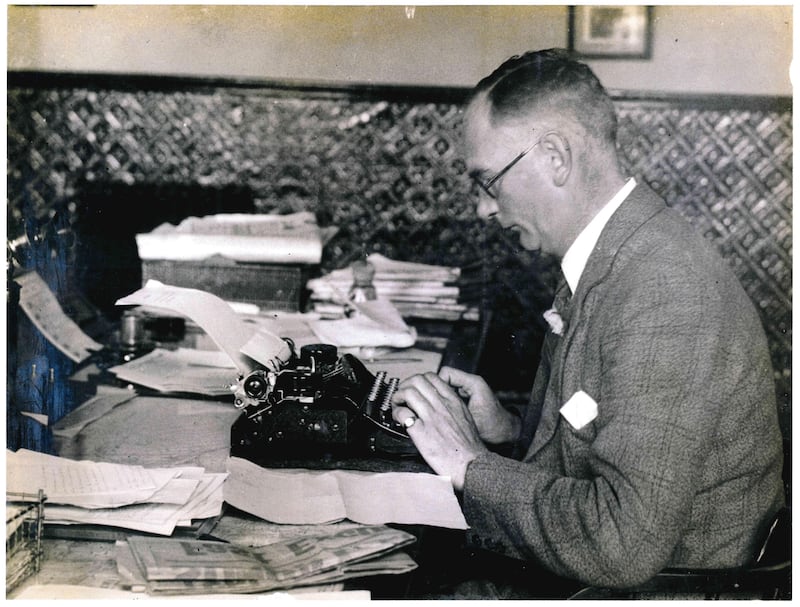
Less than three weeks later, news came over the wires that he and Brown had won the big prize.
That news was broken by Tom “Cork” Kenny. His grandson, also called Tom Kenny – of Kenny’s bookshop in Galway – heard some details of how the story unfolded in a Connemara pub in the 1970s.
"I was in a pub in Roundstone 40 years ago," he says "when someone called out to me and said: 'Was your father a journalist?' I said: 'No, but my grandfather was.' And he said 'I'm the sergeant's son'. I'd no idea what he was talking about. The man's father was the RIC sergeant in Clifden, and one of the first people to get to the site of the landing. Very quickly he realised the importance of what had happened."
The sergeant called Kenny’s grandfather. “He would’ve been the most significant journalist in the west of Ireland at the time,” Kenny says.
When the journalist got to the Marconi station, security was tight, but he met another contact who let him in. “He was allowed use the radio station to get the news out,” his grandson says. Kenny then drove the fliers to Galway, and put them up in the Great Southern Hotel on Eyre Square.
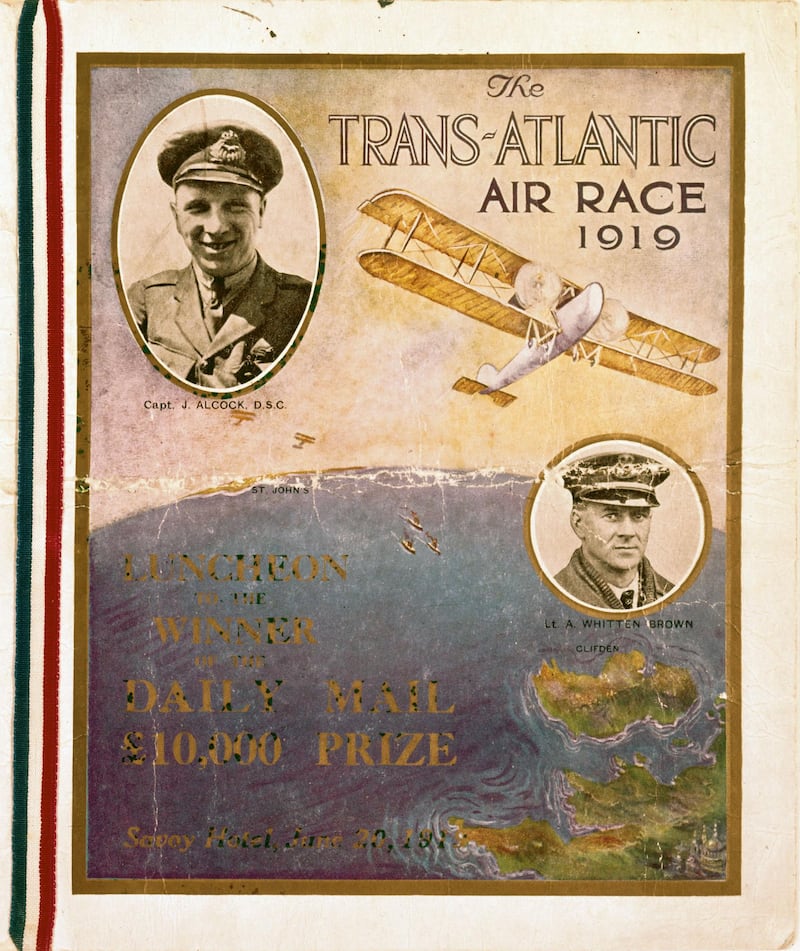
The Daily Mail had a journalist in the hotel, waiting for news of the crossing, but the first he heard of it was when Kenny’s telegram landed. He immediately set off for Clifden, unaware the men he was waiting for were heading straight for him.
“The following day, Cork’s story was on the front of every newspaper in the world,” Kenny says. “This was the equivalent of Neil Armstrong walking on the moon.”
He says: “The Great Southern Hotel had a direct link with the station, so you could walk directly from the hotel onto the station platform. According to our family story, the next morning the Dublin train pulled in and all these reporters, photographers and cameramen came rushing off it. They commandeered every mode of transport they could get their hands on, and raced to Clifden. Then my grandfather calmly walked out onto the empty platform from the hotel, with the two boys, and they took the train to Dublin.”
The two fliers were feted at every train station along the route to Dublin, and given the 'most enthusiastic reception' when they arrived at Broadstone
Kenny’s report for The Irish Times paints a vivid picture of what happened next. The two fliers were feted at every train station along the route, and given the “most enthusiastic reception” when they arrived at Dublin’s Broadstone.
They were brought to Trinity College, where "the whole hall rose to their feet and cheered vociferously. At the end of Commons, when the Latin grace had been said, the, Provost and Captain Alcock headed the procession," Kenny wrote.
That fliers were taken to the main gate, and “with about 30 students hanging on to it, the motor car drove to the Automobile Club [on Dawson Street] where the students carried Captain Alcock up the steps, and delivered him over to those waiting to receive him. After partaking of tea, they were subsequently entertained to dinner in the St Stephen’s Green Club, and spent the night as guests of the Chief Secretary for Ireland at his lodge in the Phoenix Park.”
From there, Kenny went with Alcock and Brown to London, where they were greeted by thousands of cheering well-wishers well able to muster more than a "languid hand"; despite Alcock's earlier fears. Winston Churchill presented them with their £10,000 prize, after which they were knighted by King George V. Other businesses gave them more prize money, which they shared with the Vickers crew that had built their plane.
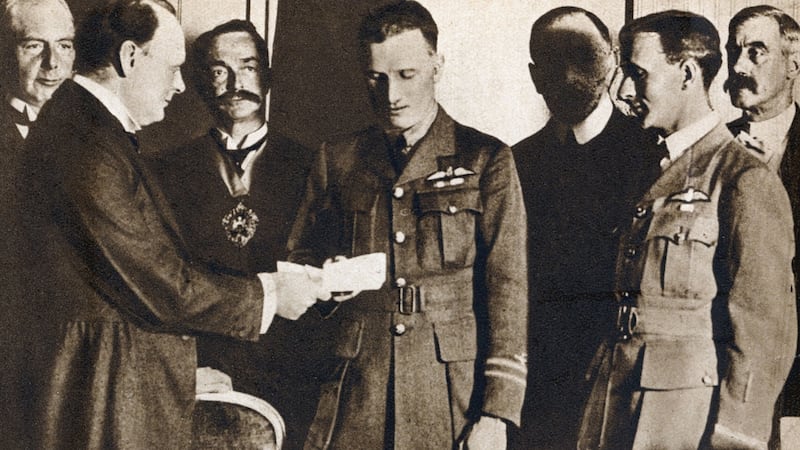
At that moment, they were the most famous men on the planet, and could have been forgiven for thinking their epic journey had secured them a permanent place amongst the greatest adventurers in human history.
So it should have done. But, within a few years, a fickle world had turned its attention to other heroes and other stories, and the men’s incredible bravery and determination quickly faded from memory.
Alcock was dead before the curtain came down on 1919. He was killed after another Vickers plane he was flying to an airshow in Paris ran into fog. He had flown low to get his bearings and hit a tree. He died en route to a French hospital.
“Alcock and Brown were both very different personalities, but they formed a real bond, and when Brown heard of Sir John’s death, it shattered his life and he became a bit of a recluse,” Tony Alcock says.
Years passed, and Brown’s tragedy was compounded when his son died while flying reconnaissance over the D-Day beaches. In 1948, Brown himself died after what is said to have been an accidental overdose of prescribed medication.
Almost immediately, Alcock and Brown became the forgotten fliers of the 20th century. There are still people who refuse to let their story die, however, and they are using the low-key centenary celebrations taking place this month in Ireland, Manchester and Canada to remind the world just how remarkable Alcock and Brown were.
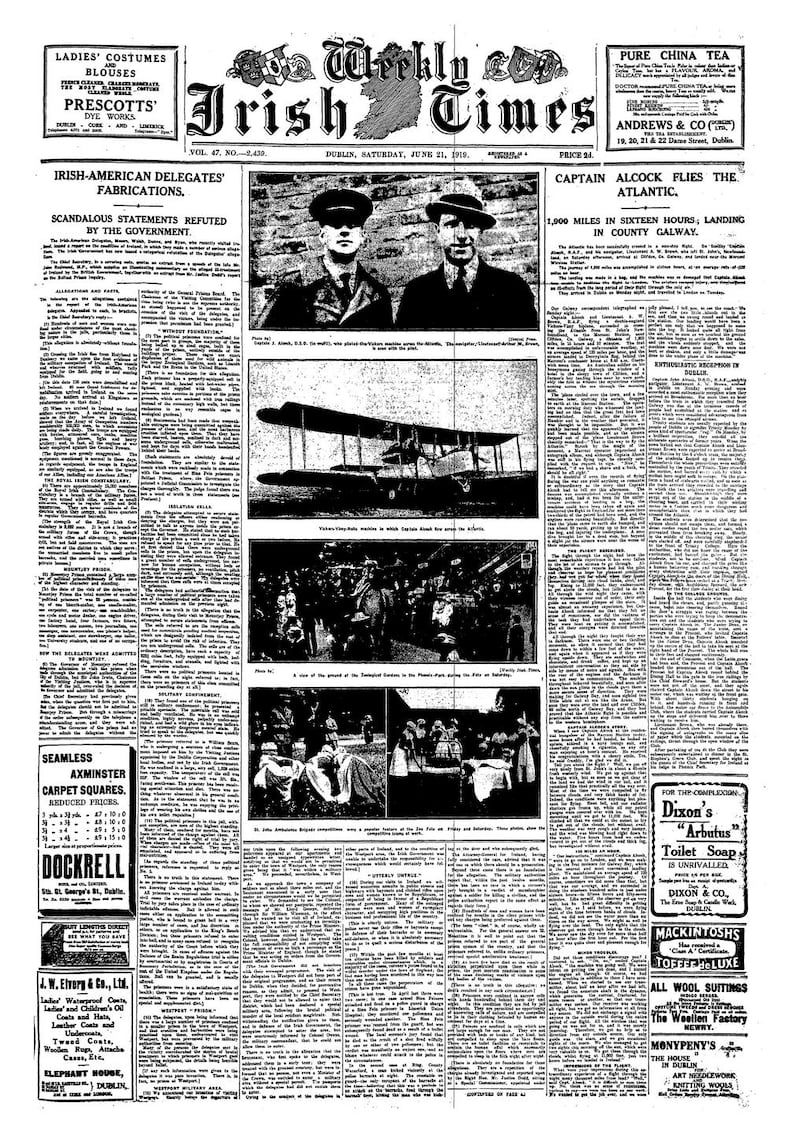
“I am genuinely mystified as to how they were forgotten,” says Brendan Lynch, author of the book Yesterday We Were In America, which tells the story of the flight in comprehensive detail.
It is a story Lynch first heard as a child in his home in Tipperary. When aviation record breaker Steve Fossett and his co-pilot Mark Rebholz successfully re-enacted the journey in 2005, Lynch was there to see the plane fly in over the Irish coast and land on a Connemara golf course. “To see that plane fluttering in off the Atlantic was one of the most rewarding experiences of my life,” he says.
"What Alcock and Brown did was the biggest aviation achievement after the Wright Brothers first hopped off the ground 16 years earlier. They opened up the Atlantic, and showed the world the possibilities aviation had.
“They are overlooked by history, I really don’t know why. I suppose Lindbergh was the clean-cut American hero, while Alcock and Brown were just not that interested in fame, they were hard workers who wanted to get on with things, and that took Americans by surprise.”
Alcock’s nephew Tony is similarly mystified by how poorly history has treated them. “What Alcock and Brown did was probably more impressive, even, then what the Wright Brothers had achieved, because they opened up the Atlantic and crossed it in the most horrendous conditions right along their intended track with only the most basic of equipment. I don’t know why they did not get the recognition they deserved.”
Lynch believes this month’s centenary celebrations, largely centred around St John’s and Clifden, should mark the moment when that great historical wrong is righted. “I hope the centenary will help people to remember the most forgotten, most overlooked men in aviation history. What they endured on that flight was unbelievable, and it should always serve as a reminder of just how far we have all come.”






















